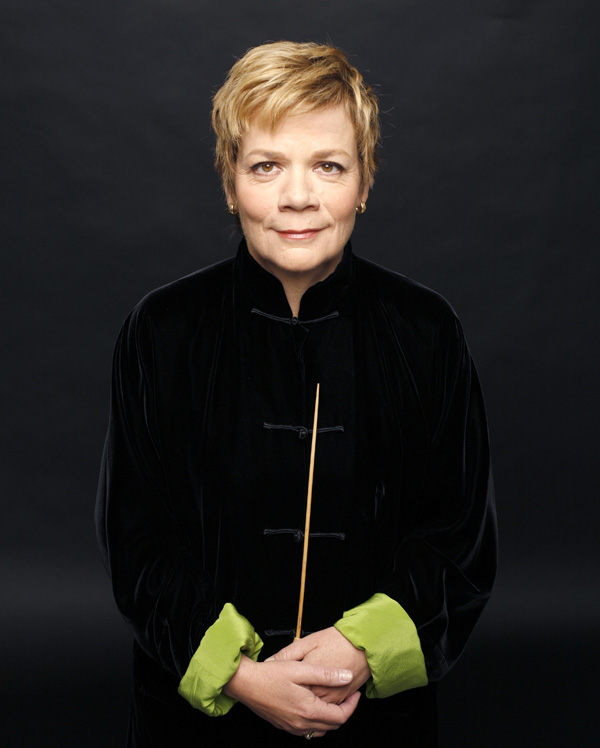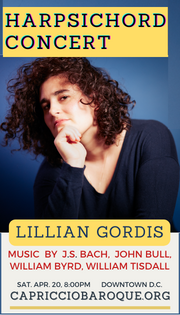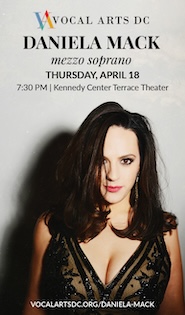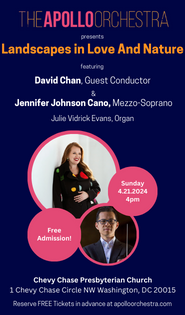Religious works highlight Alsop’s Baltimore Symphony program

Marin Alsop conducted the Baltimore Symphony Orchestra Saturday night at Strathmore. Photo: Grant Leighton
For half of this week’s Baltimore Symphony Orchestra program Marin Alsop broke out of her repertorial rut. In the Music Center at Strathmore on Saturday night the talented University of Maryland Concert Choir took center stage to perform two rare choral works from the mid-20th century.
Karl Marx infamously labeled religion ”the opium of the people,” setting the stage for a century of anti-religious persecution in Communist countries. All three of the composers featured in this program had conflicts with Soviet authorities, but the first courageously included religious elements in his music in defiance.
For Credo, composed in 1968, Estonian composer Arvo Pärt chose verses from the Gospel of Matthew, simultaneously an expression of Christian belief and opposition to violence.
At the piano Lura Johnson wove a meditative veil with Pärt’s quotation of Bach’s Prelude in C Major (from Book I of The Well-Tempered Clavier). The Latin text sung by the choir disintegrated into syllables, obliterated by a chaotic mass of sound from the orchestra, based ironically on a 12-tone row ordered on perfect fifths. Gradually the Bach material quelled this ugly noise, leaving only the simple hope expressed by the title word, a statement of resolute belief. It is a piece very much of its revolutionary era, and not always in a good way.
These were the BSO’s first performances of the work, but it was the University of Maryland Concert Choir that made this music work, entering out of silence and singing with a beautiful, poised sound. Their precision and sensitivity, under the leadership of Edward Maclary, has made them the go-to choral ensemble for both major local orchestras in the last decade.
Comparison of the Pärt to Stravinsky’s Symphony of Psalms, which followed, was not flattering. Stravinsky, too, turned back to his Orthodox faith in his neoclassical period. This extraordinary piece expresses that faith in its use of Latin texts drawn from three psalms, as well as a musical style based on modal chant and intricate polyphonic counterpoint. Stravinsky stated, in the work’s preface, that he preferred to have boys sing the upper choral parts, and the young voices of the collegiate choir made an appropriately clean, transparent sound.
The orchestral musicians remained in their original seating, which left a large swath of empty seats left empty by the violinists and violists. This arrangement unbalanced the orchestral sound when the choir was not singing, but the multitude of flutes and oboes, especially in the introduction to the second movement, was quite lovely. The choir’s pure intonation and clear diction created a hypnotic effect on the smoldering introduction to the third movement. The rhythmic coordination between orchestra and choir, ably assisted by Alsop, bristled with energy.
Concluding with Rachmaninov’s Symphony No. 2 was like pouring a one-hour bag of sugar into a spicy étouffée. Alsop aimed to keep the work exciting, making for a notably turbulent first movement. The orchestra became especially agitated in the development section, and massive crescendo sections were well paced.
The Scherzo had a pleasing, bouncy tempo, with an even sharper approach in the second trio section. Rachmaninov’s quotation of the Dies Irae chant melody, quite disguised in this case, was not really enough to bind the piece with what had come before, nor was the composer’s Russian origins.
To her credit Alsop kept the piece moving, especially in the slow movement, not allowing it to drag and featuring some lovely solos from clarinet, horn, and violin. The whole violin section had a glowing sound in the bright, quick-stepped finale, in which Alsop again hit most of the right marks. There was nothing to fault except in the score’s longueurs, which even the composer admitted by revising the work later in life, revisions that are regrettably not observed in most modern performances.
The program will be repeated 3 p.m. Sunday at Meyerhoff Symphony Hall in Baltimore. bsomusic.org; 410-783-8000.







